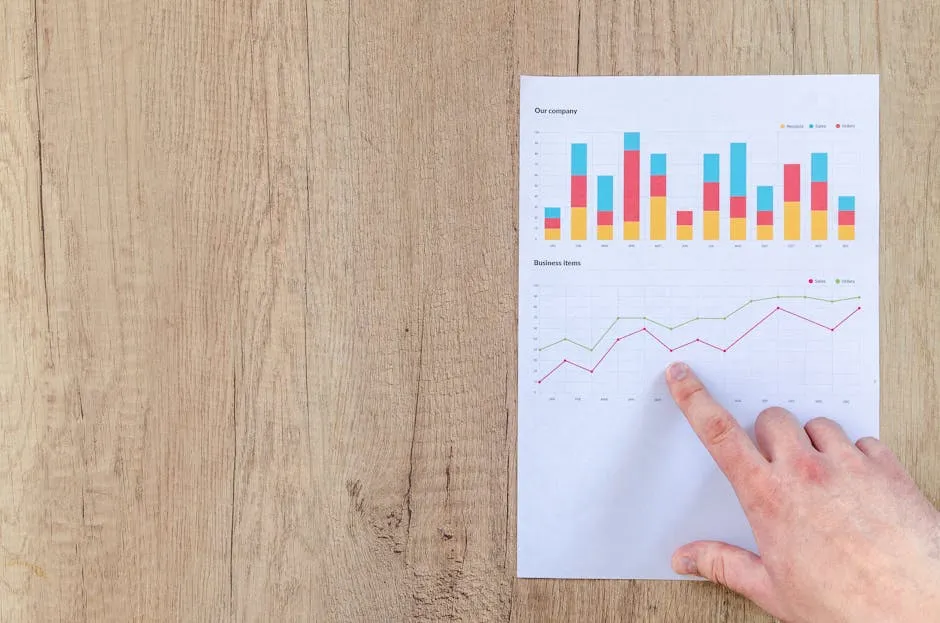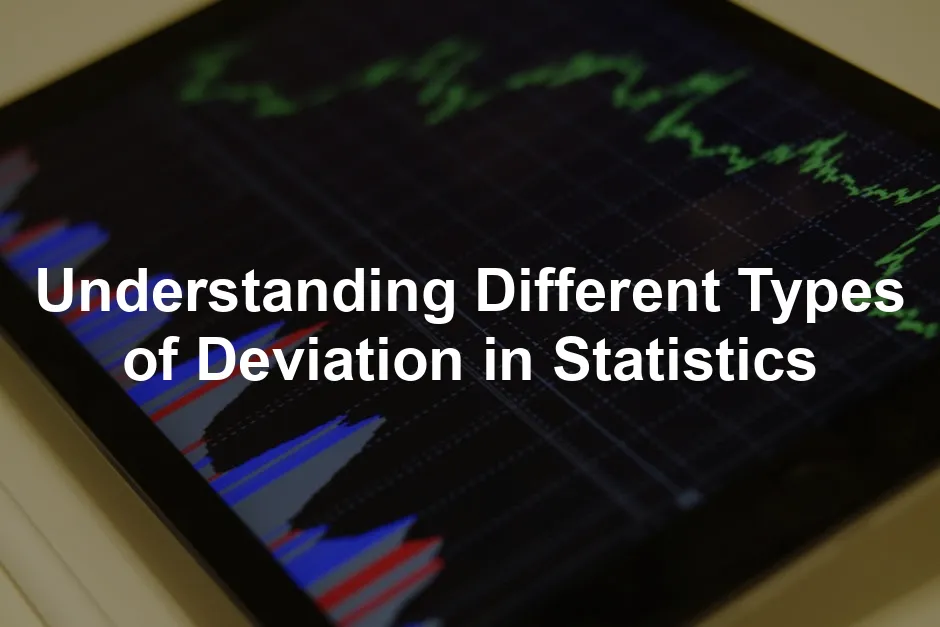Introduction
Deviation in statistics is a crucial concept. It helps analysts understand how data points spread around a central value. Imagine throwing a dart at a board. The distance from where the dart lands to the bullseye represents deviation. In statistics, this translates to how far individual data points stray from the mean.
Understanding deviation is essential for effective data analysis. It informs us about the variability in our datasets. When we say “deviation,” we’re often referring to measures of dispersion. These include standard deviation (SD) and variance. Both provide insight into how clustered or spread out our data is. If you’re looking for a great introduction to these concepts, consider checking out Statistics for Dummies, which breaks down complex ideas into easy-to-understand language.
This article focuses on different types of deviations. We will discuss standard deviation and variance in detail. Each has its unique applications and importance in various fields, from finance to quality control. By the end, you’ll have a clearer understanding of these concepts and their practical uses.

Types of Deviation in Statistics
Definition of Deviation
In statistics, “deviation” indicates how far a data point is from the mean. It’s the difference between an observed value and the average value of a dataset. To clarify further, let’s break down the types of deviation: absolute deviation, squared deviation, and standard deviation.
Absolute Deviation measures the distance of a data point from the mean, disregarding direction. It’s calculated using the formula:
Absolute Deviation = |xi – μ|
where xi is a data point, and μ is the mean.
Squared Deviation takes it a step further by squaring the absolute deviation. This method is particularly useful for variance calculations, as it emphasizes larger deviations. The formula is:
Squared Deviation = (xi – μ)2
Finally, we have Standard Deviation (SD), which is the square root of the variance. This measure provides a snapshot of how spread out the data points are around the mean. A small SD indicates that the values cluster closely to the mean, while a large SD suggests a wider spread. For those diving deeper into statistical concepts, The Elements of Statistical Learning is a fantastic resource that delves into data mining and prediction.
For example, consider the data points: 2, 4, 6, 8. The mean is 5. The absolute deviations are 3, 1, 1, and 3, respectively. The squared deviations are 9, 1, 1, and 9. The variance is the average of these squared deviations, which gives us a clearer picture of the data’s dispersion.

Importance of Deviation
Understanding deviation is key to making statistical inferences. It helps assess the reliability of data. For instance, in finance, knowing the standard deviation of stock returns is vital. A high SD indicates greater risk, while a low SD suggests stability. For more insights into statistical methods for finance professionals, you can read more about statistical methods for finance professionals 2024.
Understanding the implications of standard deviation in finance can significantly impact investment decisions. statistical methods for finance professionals 2024
In research, deviation plays a significant role in validating experimental results. It helps determine whether observed outcomes are due to chance or actual effects. For instance, if a drug shows a significant effect with a low SD in clinical trials, researchers can be more confident in its efficacy.
Quality control processes also leverage deviation. Manufacturers often monitor product consistency. If a particular measurement shows high deviation, it signals a potential issue in production. This proactive approach can prevent costly errors. To ensure quality control in your data processes, consider leveraging Data Analysis with Open Source Tools for a comprehensive approach.
In summary, understanding deviation not only aids in data interpretation but also enhances decision-making across various sectors. By grasping these concepts, professionals can navigate their respective fields with greater confidence and clarity.

Standard Deviation
Introduction to Standard Deviation
Standard deviation (SD) is a statistical measure that quantifies the amount of variation or dispersion in a set of values. It indicates how much individual data points differ from the mean (average) of the dataset. Mathematically, the population standard deviation is represented by the Greek letter σ (sigma), while the sample standard deviation is denoted by the letter s.
To understand standard deviation, we first need to grasp its relationship with variance. Variance is the average of the squared differences from the mean. The formula for variance is:
σ2 = (Σ (xi – μ)2) / N
where xi represents each data point, μ is the mean, and N is the total number of data points. The standard deviation is simply the square root of the variance:
σ = √σ2

This relationship shows how standard deviation derives from variance, providing a more interpretable measure of dispersion since it is expressed in the same units as the original data. If you’re looking to dive deeper into data analysis, Data Science for Business is an excellent resource that covers data-analytic thinking.
Calculation of Standard Deviation
Calculating the standard deviation involves a few clear steps. We’ll look at how to compute it for both populations and samples.
Step-by-Step Instructions for Population SD
1. Calculate the Mean (µ): Add all the data points together and divide by the number of points.
For example, consider the data set: 4, 8, 6, 5, 3.
μ = (4 + 8 + 6 + 5 + 3) / 5 = 5.2
2. Find Each Deviation from the Mean: Subtract the mean from each data point.
– 4 – 5.2 = -1.2
– 8 – 5.2 = 2.8
– 6 – 5.2 = 0.8
– 5 – 5.2 = -0.2
– 3 – 5.2 = -2.2
3. Square Each Deviation: Square the result of each deviation.
– (-1.2)2 = 1.44
– (2.8)2 = 7.84
– (0.8)2 = 0.64
– (-0.2)2 = 0.04
– (-2.2)2 = 4.84
4. Calculate the Variance: Take the average of these squared deviations.
σ2 = (1.44 + 7.84 + 0.64 + 0.04 + 4.84) / 5 = 2.96
5. Find the Standard Deviation: Take the square root of the variance.
σ = √2.96 ≈ 1.72
Example Calculation for Sample SD
1. Calculate the Mean (x̄): For a sample data set: 5, 7, 9.
x̄ = (5 + 7 + 9) / 3 = 7
2. Find Each Deviation from the Mean:
– 5 – 7 = -2
– 7 – 7 = 0
– 9 – 7 = 2
3. Square Each Deviation:
– (-2)2 = 4
– (0)2 = 0
– (2)2 = 4
4. Calculate the Sample Variance: Sum the squared deviations and divide by n – 1 (where n is the number of samples).
s2 = (4 + 0 + 4) / (3 – 1) = 8 / 2 = 4
5. Find the Sample Standard Deviation:
s = √4 = 2

Interpretation of Standard Deviation
Interpreting the standard deviation is crucial for understanding data distribution. A low standard deviation indicates that the data points are close to the mean, suggesting consistency. Conversely, a high standard deviation signals that the data points are spread out over a larger range, indicating variability.
In practical terms, consider these examples:
1. Finance: In investment portfolios, a high standard deviation reflects greater risk, as the returns can fluctuate widely. A stable investment, however, will have a low standard deviation, showing predictable returns. For a deep dive into financial analytics, check out Data Science for Marketing Analytics.
2. Healthcare: In clinical trials, a low standard deviation in patient responses to a treatment indicates that most patients are experiencing similar effects, which is often desirable. A high standard deviation might suggest varied responses, prompting further investigation.
3. Education: Analyzing test scores, a low standard deviation means students performed similarly, while a high standard deviation indicates a wide range of scores. This can inform teaching strategies and curriculum adjustments.
In conclusion, standard deviation is a powerful tool in statistics, providing insights into data variability. It aids in making informed decisions across various fields, from finance to healthcare and education. Understanding how to calculate and interpret standard deviation is essential for anyone working with data.

Variance
Definition of Variance
Variance quantifies how much data points differ from the mean. It helps in understanding the spread of data. The relationship between variance and standard deviation is straightforward: the standard deviation is simply the square root of the variance.
To calculate variance, we use two formulas depending on the context. For a population, the formula is:
σ2 = (Σ (xi – μ)2) / N
For a sample, the formula adjusts slightly to account for the smaller dataset:
s2 = (Σ (xi – x̄)2) / (n – 1)
Here, xi represents each data point, μ is the population mean, x̄ is the sample mean, N is the total number of data points in the population, and n is the number of observations in the sample.

Calculation of Variance
Calculating variance involves several steps. Let’s break it down for both population and sample variance.
Steps for Population Variance
1. Calculate the Mean (μ): Add all data points and divide by the number of points.
Example data: 4, 8, 6, 5, 3.
μ = (4 + 8 + 6 + 5 + 3) / 5 = 5.2
2. Find Each Deviation from the Mean: Subtract the mean from each data point.
3. Square Each Deviation: This emphasizes larger deviations.
Example calculations:
– (4 – 5.2)2 = 1.44
– (8 – 5.2)2 = 7.84
– (6 – 5.2)2 = 0.64
4. Calculate the Variance: Average the squared deviations.
σ2 = (1.44 + 7.84 + 0.64 + 0.04 + 4.84) / 5 = 2.96
5. Find the Standard Deviation (σ): Take the square root of the variance.
σ = √2.96 ≈ 1.72
Steps for Sample Variance
1. Calculate the Mean (x̄): For the sample data: 5, 7, 9.
x̄ = (5 + 7 + 9) / 3 = 7
2. Find Each Deviation from the Mean:
– 5 – 7 = -2
– 7 – 7 = 0
– 9 – 7 = 2
3. Square Each Deviation:
– (-2)2 = 4
– (0)2 = 0
– (2)2 = 4
4. Calculate the Sample Variance:
s2 = (4 + 0 + 4) / (3 – 1) = 8 / 2 = 4
5. Find the Sample Standard Deviation (s):
s = √4 = 2

Importance of Variance
Variance plays a crucial role in statistical analysis. It complements standard deviation by providing a squared measure of dispersion. While standard deviation offers an easily interpretable metric, variance is essential for various statistical methods, including hypothesis testing and confidence intervals. If you’re new to these concepts, you might find Statistical Analysis with Excel for Dummies particularly helpful.
When conducting hypothesis tests, variance helps determine the variability within data. A low variance indicates that the data points are closely grouped around the mean, allowing for more precise conclusions. Conversely, a high variance suggests a wider spread, prompting further investigation into the data’s nature.
In confidence intervals, variance informs the margin of error. A smaller variance results in a narrower interval, enhancing the reliability of the estimate. In summary, variance is not merely a number; it provides context and depth to data analysis, influencing decisions across fields like finance, healthcare, and education.

Practical Examples and Case Studies
Example 1: Analyzing Student Exam Scores
Imagine we have a dataset of exam scores from a class of students: 85, 90, 78, 92, 88. Let’s calculate the variance and standard deviation to understand student performance.
1. Calculate the Mean:
x̄ = (85 + 90 + 78 + 92 + 88) / 5 = 86.6
2. Find Each Deviation from the Mean:
– 85 – 86.6 = -1.6
– 90 – 86.6 = 3.4
– 78 – 86.6 = -8.6
– 92 – 86.6 = 5.4
– 88 – 86.6 = 1.4
3. Square Each Deviation:
– (-1.6)2 = 2.56
– (3.4)2 = 11.56
– (-8.6)2 = 73.96
– (5.4)2 = 29.16
– (1.4)2 = 1.96
4. Calculate the Variance:
σ2 = (2.56 + 11.56 + 73.96 + 29.16 + 1.96) / 5 = 23.84
5. Find the Standard Deviation:
σ = √23.84 ≈ 4.88

The results indicate that the students’ scores vary significantly around the mean. With a variance of 23.84 and a standard deviation of approximately 4.88, we can conclude that while some students performed well, others struggled considerably. For more data-driven insights in education, consider The Art of Statistics: Learning from Data, which provides a great overview of statistical principles.
This variance analysis helps educators identify where additional support might be needed, ensuring that no student is left behind. Understanding variance and standard deviation empowers stakeholders to make informed decisions, enhancing educational outcomes.

Limitations and Alternatives to Standard Deviation
Limitations
While standard deviation (SD) is a widely used measure, it has its limitations. One major issue is its sensitivity to outliers. A single extreme value can significantly skew the SD, making it appear larger than it might be otherwise. For example, consider a dataset of salaries: $30,000, $32,000, $31,000, and $1,000,000. The SD will inflate due to that one high value, leading to misleading conclusions about the typical salary within the group.
Furthermore, SD assumes a normal distribution of data. In real life, many datasets are not normally distributed, especially in fields like finance and social sciences. In such cases, the SD may not accurately reflect the data’s variability. For skewed distributions, alternative measures may provide better insights. If you’re interested in exploring these alternatives, Data Science from Scratch offers a foundational understanding of these concepts.
Lastly, standard deviation is expressed in the same units as the data. This can complicate comparisons across datasets with different units or scales. For instance, comparing the SD of test scores (out of 100) to income data (in dollars) can be tricky and may require conversion or normalization to make sense.

Alternatives
Fortunately, several alternative measures of dispersion can complement or replace standard deviation, depending on the situation.
1. Interquartile Range (IQR): The IQR measures the range between the first quartile (25th percentile) and the third quartile (75th percentile). This method focuses on the middle 50% of the data, providing a robust measure that is less affected by outliers. It’s particularly useful in box plots, where it highlights the central distribution of the data.
2. Mean Absolute Deviation (MAD): The MAD calculates the average absolute deviations from the mean. It avoids squaring the differences, which makes it less sensitive to outliers than SD. The formula is straightforward:
MAD = (Σ |xi – x̄|) / n
where xi represents the individual data points, x̄ is the mean, and n is the total number of points.
3. Coefficient of Variation (CV): The CV expresses the standard deviation as a percentage of the mean. It’s particularly beneficial for comparing variability between datasets with different units or means. The formula is:
CV = (σ / x̄) × 100
A higher CV indicates greater relative variability, making it a helpful metric in fields like finance, where return rates are assessed.

In summary, while standard deviation is a valuable tool for understanding data dispersion, it’s essential to recognize its limitations. By considering alternatives like the IQR, MAD, and CV, analysts can gain a more nuanced understanding of data variability and make better-informed decisions.
Conclusion
In summary, understanding deviation, standard deviation, and variance is fundamental for effective statistical analysis. Deviation measures how far individual data points stray from the mean. It helps us grasp the spread or dispersion of data, revealing insights that are crucial in various fields.
Standard deviation (SD) quantifies the amount of variation in a dataset. It tells us whether our data points are closely clustered around the mean or widely scattered. Low SD suggests consistency, while high SD indicates variability. Variance, on the other hand, provides the average of the squared differences from the mean and is essential for many statistical tests.
Recognizing the differences between these concepts is vital. For example, while both SD and variance measure data spread, SD is often more interpretable since it is in the same units as the data. Variance, being expressed in squared units, often requires additional context for comprehensibility.
These statistical measures have practical applications across various domains. In finance, they help assess risk and volatility, guiding investment strategies. In healthcare, they aid in understanding patient responses to treatments, ensuring evidence-based practices. Quality control in manufacturing relies on these concepts to maintain consistent product standards.

To harness the full potential of statistical analysis, professionals should apply these concepts in their respective fields. Use standard deviation and variance to make sense of data, identify trends, and inform decision-making. By doing so, you’ll enhance your analytical skills and contribute to better outcomes in your work. Don’t forget to complement your learning with The Data Warehouse Toolkit for a more in-depth understanding of data modeling.
FAQs
What is the difference between sample and population standard deviation?
The primary difference lies in the datasets they represent. Population standard deviation (σ) uses data from the entire population, while sample standard deviation (s) uses a subset of that population. This distinction affects the calculation, as the sample standard deviation divides by n – 1 to correct for bias, providing a more accurate estimate of the population standard deviation.
When should I use standard deviation vs. variance?
Use standard deviation when you want a measure that is easily interpretable because it’s in the same unit as your data. Variance is more appropriate in theoretical contexts, such as hypothesis testing. If you’re comparing datasets or assessing risk in finance, standard deviation is usually the go-to metric. Variance is often used in calculations leading to standard deviation.
Can standard deviation be negative?
No, standard deviation cannot be negative. It’s a measure of spread, calculated as the square root of variance, which is always a non-negative value. A standard deviation of zero indicates that all data points are identical, while a positive standard deviation signifies variability in the dataset.
How does standard deviation relate to normal distribution?
In a normal distribution, standard deviation plays a critical role in defining how data is distributed. About 68% of data falls within one standard deviation of the mean, approximately 95% within two standard deviations, and about 99.7% within three. This relationship helps in understanding probabilities and making predictions based on the data.
What are the implications of a high standard deviation in a dataset?
A high standard deviation indicates significant variability among data points. This can suggest inconsistency, greater risk in financial contexts, or diverse responses in experimental settings. It may require further investigation to understand the causes of such variability. Identifying high variability can inform strategies for improvement or risk management.
Please let us know what you think about our content by leaving a comment down below!
Thank you for reading till here 🙂
All images from Pexels




